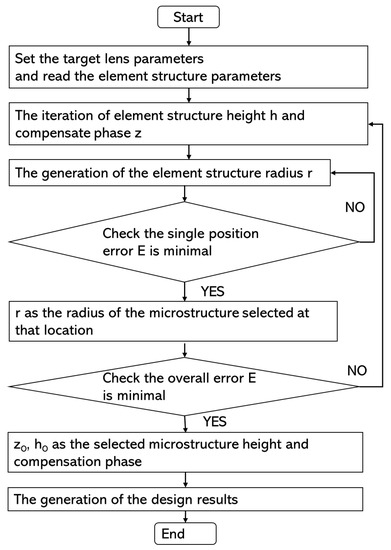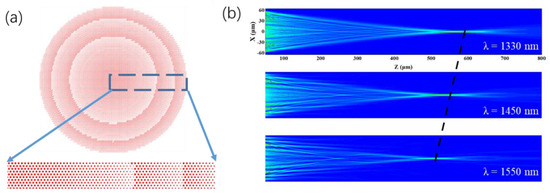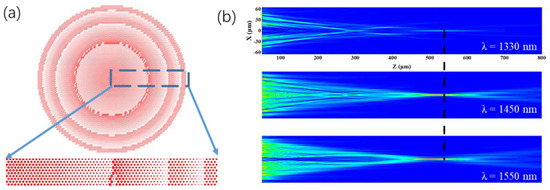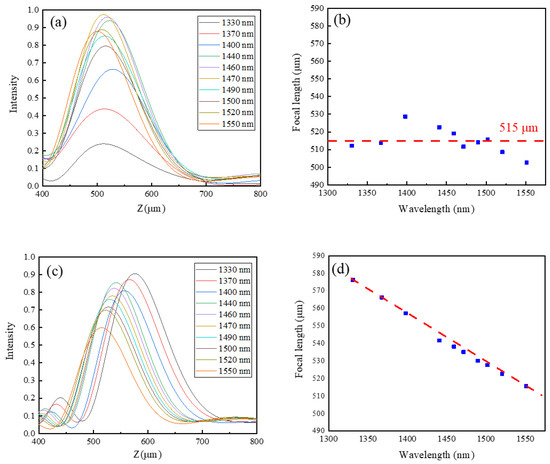Abstract
We proposed a single metalens for fiber coupling within telecom bands. This proposed fiber coupler combined a single layer metalens and a Polydimethylsiloxane (PDMS) layer. Instead of traditional fiber collimators, which are bulky and require complex calibration processes, we used a metalens for the focusing of incident and outgoing lasers and achieve achromatic aberration over a certain wavelength band. The focal length was kept as 514.9 μm with a 6.92-μm tolerance. The average coupling efficiency of an achromatic lens was calculated as 0.43. The different phases were produced with the nanopillar element structures. The aim is to provide an idea for creating a more convenient, integrated and efficient way of coupling fiber optics. This approach can also be applied to the design of achromatic lenses in other wavelength regions.
1. Introduction
Optical fibers rely on total internal reflections for light propagations [1] and have ultralow losses in infrared (IR) band with strong anti-electromagnetic interference ability [2]. Optical fibers are mainly used in optical communications [3], and are widely used in the chemical industry, in medicine, telecommunications and other fields [4,5,6]. In biomedical fields, fiber-based multi-functional spectral-domain optical coherence tomography (OCT) systems [7] can deliver ultrahigh resolution OCT imaging. Optical endoscopy [8] can perform subtle imaging of the inside of the human body and play a role in disease diagnosis and surgical treatment. These fiberscopes are mainly divided into two broad categories, one is scanning imaging using single-mode fibers. The other approach is using multi-core fibers [9] or fiber bundles directly for wide-area illuminations and image transmissions [10]. In the industrial field, optical fibers also have lots of applications, such as temperature, pressure, strain and chemical sensors as well as optical gyroscopes [11]. The distributed fiber optic sensing technology [12,13] can realize the protection of buildings [14], bridges, dams, tunnels and other important civil engineering infrastructures, and also can be applied for structural inspection and evaluation [15] of mobility equipment such as automobiles and aircraft [16]. In addition, the functionality of optical fibers in other areas include the use of optical fibers to construct optical capturing wells [17,18], nonlinear light generation [19] and magnetic field sensing [20].
Due to the geometrical limits of optical fibers, one typically relies on fiber collimators [21] to couple laser beams into the fibers [22], or collimate the outgoing lights [23] for signal capturing. These processes require a sophisticated optical alignment stage. In addition, fiber collimators have a large volume which is not conducive to the use of lightweight integrated systems using optical fibers for the fields of endoscopes and optical communications. Existing achromatic techniques mainly rely on complex lens groups, that is, gluing multiple aspheric lenses to correct chromatic aberration [24]. This inevitably leads to large thicknesses, complex industrial processes, higher production costs and undesirable systematic errors [25].
However, due to the constraints of the lens geometry and refractive index distribution, chromatic aberrations occur during the light coupling processes. For instance, the dispersion induces chromatic focusing. Typically, aspherical lenses are commonly chosen for coupling the laser beam into fibers. The precise alignment is always needed. Plidschun et al. [26] implemented an ultrathin metalens on the facet of a modified single-mode optical fiber via direct laser writing, leading to a diffraction-limited focal spot. In addition, the metasurface around the side surface of an optical fiber was designed by Lei et al. [27] for light focusing. In addition, Xu and Shi [28] showed the metamaterial-based Maxwell’s fisheye lens for multimode waveguide crossing. Zhang et al. [29] proposed a broadband mode size converter using an on-chip metamaterial-Based Luneburg Lens. Recently, Ren et al. [30] designed a 3D achromatic diffraction metalens on the end face of a single-mode fiber that is capable of achromatic aberration over the entire near-IR telecom wavelength band from 1.25 to 1.65 μm and achieve polarization-insensitive focusing.
In this work, an achromatic flat fiber coupler was proposed and designed. This proposed fiber coupler combines a single layer metalens and a Polydimethylsiloxane (PDMS) layer. Instead of traditional fiber collimators, which are bulky and require complex calibration processes, we used a metalens for the focusing of incident and outgoing lasers and achieve achromatic aberration over a certain wavelength band. Although researchers are actively exploring the use of visible light bands for optical communications [31], mature optical communication technologies are still mainly concentrated in the near-IR band, so we designed achromatic metalens that operate in the 1250–1650 nm band and fixed them to the fiber end face with the help of PDMS as a medium. The aim is to provide an idea for creating a more convenient, integrated and efficient way of coupling fiber optics.
2. Materials and Methods
2.1. The Structure of This Designed Metasurface Fiber Coupler
This proposed fiber coupler (shown in Figure 1a) combined a single metalens and a PDMS layer. A common type of a single-mode fiber (SMF-28-J9, Thorlabs, Newton, NJ, USA) with its core diameter is 8.2 μm and NA = 0.14 was chosen. The metasurface fiber coupler was shown in Figure 1b and included three parts: (1) the supported PDMS layer, (2) the SiO2 layer, (3) the metasurface TiO2 layer. The thickness of the supported PDMS layer was approximately set as >500 μm. Moreover, it can directly be attached on the end faces of an optical fiber. The refractive index of PDMS was measured as 1.4 around the telecom band by Kácik et al. [32].

Figure 1.
(a) The optical layout of the single-mode fiber and the this designed metasurface fiber coupler; (b) The structure of this designed metalens fiber coupler: (1) the supported PDMS layer, (2) the SiO2 layer, (3) the metasurface TiO2 layer.
2.2. The Design Process of the Metalens
The material of the nanopillar was selected according to the required working band. For the telecom band (1350–1550 nm), we selected TiO2 as the material of the nanopillar and SiO2 as the substrate due to good transmittance of TiO2 in the telecom band. Additionally, this TiO2/SiO2 can make the design of meta lenses have higher efficiency. In Figure 2, we showed the workflow chart for the design process of the meta lens.

Figure 2.
The workflow chart for the design process of the metalens.
In terms of matching the ideal phase plane and the element structure, due to process limitations, we take the height of the microstructure as an invariant and the radius of the cylinder as the variable that produces different phase shifts. Therefore, the optimization of the height h0 is used as a large cycle, and the optimization of radius r is used as a small cycle. Finally, the h0 with the optimal evaluation index is selected as the microstructured height.
In the phase matching processes, some phase folding regions occupied small areas, and often produced extremely residual sum of squares due to error (SSE), which we call ‘dead pixels’. This resulted in the matching effect becoming poor. In contrast, the phase unfolded area contains the central area of the lens, which are ‘good pixels’. The SSE of the dead pixels is typically 10~200 times the good pixels. Herein, dynamic weighting is introduced. A small number of dead pixels did not significantly affect the focusing effect. Therefore, we reduced the weight of the dead pixels in the total error to eliminate the influence of dead pixels. Good design results were obtained. In addition, we introduced a zero-compensation factor z for the cell structure, that is, the zero point of the target phase can match any point of the cell structure phase, rather than just matching the zero point to the zero point. A new dimension has been added to the limited cell structure database to improve the match ing effect.
3. Results and Discussions
3.1. The Design of Single-Band Fiber Coupler
At first, we designed the single-frequency focal lens with metasurface for fiber coupling. The designed wavelength was set as 1450 nm and the focal length was set as 540 μm. The lens diameter is 125 μm and the numerical aperture was 0.12. The ideal phase term is presented as
where ψ is phase term, λ is the preset wavelength (1450 nm), f is the preset focal length (540 μm), and R is the distance from the center of the lens in spatial coordinates.
Based on the workflow chart for the design process of the metasurface (shown in Figure 2), the nanostructured layout of the designed single-band metalens was shown in Figure 3a. The focal length can be perfectly matched to 540 μm when the operation wavelength is 1450 nm. The nanostructured layout of the designed single-band metalens was shown in Figure 4a. The unit structure is made of TiO2, which is set as a 1.8-μm high nanopillar. The diameter of the nanopillars varied from 0.2 μm to 0.8 μm with the step size of 0.02 μm, which is used to generate phases from 0 to 2π. The 200-μm thick SiO2 was designed as the substrate. The phase terms generated by the simulation process and were used to construct the electromagnetic field distributions. The lateral optical intensity distributions were created. Figure 3b showed the lateral optical intensity distributions at 1330 nm, 1450 nm, and 1550 nm, respectively. However, the focal length of this designed metalens was 578 μm when the operation wavelength is tuned to 1330 nm and 515 μm when the operation wavelength is tuned to 1550 nm. The lateral chromatic focusing induces the additional coupling losses and the dispersions.

Figure 3.
(a) The nanostructured layout of the designed single-band metalens; (b) the lateral optical intensity distributions at 1330 nm, 1450 nm, and 1550 nm.
3.2. The Design of Broad-Band Fiber Coupler
Here, we designed the achromatic focal lens with metasurface for fiber coupling. The designed wavelength was set as 1450 nm and the focal length was set as 515 μm. The lens diameter is 125 μm and the numerical aperture was 0.12. The phase term is presented as
where λi is the desired wavelength, i was set as 10 wavelength locations from 1330 nm to 1550 nm. f is the preset focal length (515 μm), and R is the distance from the center of the lens in spatial coordinates. Based on the workflow chart for the design process of the metasurface (shown in Figure 2), the selection rule was shown as
and
The matrix information of the same height element (h0) corresponding to the phase closest to the focus points can be obtained for each wavelength, that is, the phase of each wavelength focused to f can be confirmed. The nanostructured layout of the designed single-band metalens was shown in Figure 4a. The unit structure is made of TiO2, which is set as a 1.8-μm high nanopillar. The diameter of the nanopillars varied from 0.2 μm to 0.8 μm with the step size of 0.02 μm, which is used to generate phases from 0 to 2π. The 200-μm thick SiO2 was designed as the substrate. Figure 4b showed the lateral optical intensity distributions at 1330 nm, 1450 nm, and 1550 nm. The focal lengths for different wavelengths were kept as constant and matched as 515 nm.


Figure 4.
(a) The nanostructured layout of the designed achromatic lens; (b) the lateral optical intensity distributions at 1330 nm, 1450 nm, and 1550 nm.
3.3. The Optical Performance of Achromatic Lens
The light intensity distribution of achromatic metalens with different wavelengths is shown in Figure 5a. The average coupling efficiency of achromatic lens was calculated as 0.43. Additionally, their focal length with different wavelengths was marked in Figure 5b. The preset focal length was 515 μm. The focal length of the designed achromatic metalens was kept as 514.9 μm with a 6.92-μm tolerance. On the other hand, we also showed the light intensity patterns with different wavelengths (shown in Figure 5c) of a chromatic metalens and their focal length with different wavelengths (shown in Figure 5d).

Figure 5.
The simulation results. (a) the light intensity patterns and (b) the focal length of achromatic metalens with different wavelengths; (c) the light intensity patterns and (d) the focal length of chromatic metalens with different wavelengths.
4. Conclusions
We explored a compact and light design for optical fibers for light transmitting and receiving. In this work, we proposed a flat achromatic fiber coupler. The optical coupling was immune to light polarizations because of the centrosymmetric design. The focal length was kept as 514.9 μm with a 6.92-μm tolerance. The aim is to provide an idea for creating a more convenient, integrated and efficient way of coupling fiber optics. The designed method can be directly applied to other optical fiber collimation systems with other sizes and focal lengths. The assembly errors between the fiber coupler and the fiber end face may occur. This study is ongoing.
Author Contributions
Conceptualization, J.L., X.J. and H.-C.C.; Methodology, J.L. and X.C.; Data Analysis, J.L., X.X. and R.L.; Writing and Supervision, H.-C.C. All authors have read and agreed to the published version of the manuscript.
Funding
Fundamental Research Funds for the Central Universities, China (DUT18RC(3)047 and DUT20RC(5)028).
Institutional Review Board Statement
Not applicable.
Informed Consent Statement
Not applicable.
Data Availability Statement
The data presented in this study are available on request from the corresponding author.
Conflicts of Interest
The authors declare no conflict of interest.
References
- Senior, J.M.; Jamro, M.Y. Optical Fiber Communications: Principles and Practice; Financial Times/Prentice Hall: Harlow, UK, 2009; pp. xviii+558. [Google Scholar]
- Gai, L.; Li, J.; Zhao, Y. Preparation and application of microfiber resonant ring sensors: A review. Opt. Laser Technol. 2017, 89, 126–136. [Google Scholar] [CrossRef]
- Marin-Palomo, P.; Kemal, J.N.; Karpov, M.; Kordts, A.; Pfeifle, J.; Pfeiffer, M.H.P.; Trocha, P.; Wolf, S.; Brasch, V.; Anderson, M.H.; et al. Microresonator-based solitons for massively parallel coherent optical communications. Nature 2017, 546, 274–279. [Google Scholar] [CrossRef]
- Essiambre, R.-J.; Tkach, R.W. Capacity Trends and Limits of Optical Communication Networks. Proc. IEEE 2012, 100, 1035–1055. [Google Scholar] [CrossRef]
- Richardson, D.J.; Fini, J.M.; Nelson, L.E. Space-division multiplexing in optical fibres. Nat. Photonics 2013, 7, 354–362. [Google Scholar] [CrossRef]
- Chong, A.; Buckley, J.; Renninger, W.; Wise, F. All-normal-dispersion femtosecond fiber laser. Opt. Express 2006, 14, 10095–10100. [Google Scholar] [CrossRef]
- Park, B.H.; Pierce, M.C.; Cense, B.; Yun, S.-H.; Mujat, M.; Tearney, G.J.; Bouma, B.E.; de Boer, J. Real-time fiber-based multi-functional spectral-domain optical coherence tomography at 13 µm. Opt. Express 2005, 13, 3931–3944. [Google Scholar] [CrossRef]
- Pahlevaninezhad, H.; Khorasaninejad, M.; Huang, Y.-W.; Shi, Z.; Hariri, L.P.; Adams, D.C.; Ding, V.; Zhu, A.; Qiu, C.-W.; Capasso, F.; et al. Nano-optic endoscope for high-resolution optical coherence tomography in vivo. Nat. Photonics 2018, 12, 540–547. [Google Scholar] [CrossRef]
- Shin, J.; Tran, D.N.; Stroud, J.R.; Chin, S.; Tran, T.D.; Foster, M.A. A minimally invasive lens-free computational microendoscope. Sci. Adv. 2019, 5, eaaw5595. [Google Scholar] [CrossRef]
- Shahmoon, A.; Aharon, S.; Kruchik, O.; Hohmann, M.; Slovin, H.; Douplik, A.; Zalevsky, Z. In vivo minimally invasive interstitial multi-functional microendoscopy. Sci. Rep. 2013, 3, 1805. [Google Scholar] [CrossRef]
- Passaro, V.M.N.; Cuccovillo, A.; Vaiani, L.; De Carlo, M.; Campanella, C.E. Gyroscope Technology and Applications: A Review in the Industrial Perspective. Sensors 2017, 17, 2284. [Google Scholar] [CrossRef]
- Barrias, A.; Casas, J.R.; Villalba, S. A review of distributed optical fiber sensors for civil engineering applications. Sensors 2016, 16, 748. [Google Scholar] [CrossRef] [PubMed]
- Bao, X.; Chen, L. Recent Progress in Distributed Fiber Optic Sensors. Sensors 2012, 12, 8601–8639. [Google Scholar] [CrossRef] [PubMed]
- Yeo, T.L.; Eckstein, D.; McKinley, B.; Boswell, L.F.; Sun, T.; Grattan, K.T.V. Fibre-optic sensor for the monitoring of moisture ingress and porosity of concrete. In Proceedings of the 17th International Conference on Optical Fibre Sensors, Brugge, Belgium, 23–27 May 2005; pp. 491–494. [Google Scholar]
- Ansari, F. Structural health monitoring with fiber optic sensors. Front. Mech. Eng. China 2009, 4, 103–110. [Google Scholar] [CrossRef]
- Bednarska, K.; Sobotka, P.; Woliński, T.R.; Zakręcka, O.; Pomianek, W.; Nocoń, A.; Lesiak, P. Hybrid Fiber Optic Sensor Systems in Structural Health Monitoring in Aircraft Structures. Materials 2020, 13, 2249. [Google Scholar] [CrossRef]
- Constable, A.; Kim, J.; Mervis, J.; Zarinetchi, F.; Prentiss, M. Demonstration of a fiber-optical light-force trap. Opt. Lett. 1993, 18, 1867–1869. [Google Scholar] [CrossRef]
- Asadollahbaik, A.; Thiele, S.; Weber, K.; Kumar, A.; Drozella, J.; Sterl, F.; Herkommer, A.M.; Giessen, H.; Fick, J. Highly Efficient Dual-Fiber Optical Trapping with 3D Printed Diffractive Fresnel Lenses. Acs Photonics 2019, 7, 88–97. [Google Scholar] [CrossRef]
- Sollapur, R.; Kartashov, D.; Zürch, M.; Hoffmann, A.; Grigorova, T.; Sauer, G.; Hartung, A.; Schwuchow, A.; Bierlich, J.; Kobelke, J.; et al. Resonance-enhanced multi-octave supercontinuum generation in antiresonant hollow-core fibers. Light. Sci. Appl. 2017, 6, e17124. [Google Scholar] [CrossRef]
- Zhou, X.; Li, X.; Li, S.; An, G.-W.; Cheng, T. Magnetic Field Sensing Based on SPR Optical Fiber Sensor Interacting With Magnetic Fluid. IEEE Trans. Instrum. Meas. 2018, 68, 234–239. [Google Scholar] [CrossRef]
- Ghasemi, S.; Hantehzadeh, M.; Sabbaghzadeh, J.; Dorranian, D.; Vatani, V.; Babazadeh, A.; Hejaz, K.; Hemmati, A.; Lafouti, M. Designing a plano-convex aspheric lens for fiber optics collimator. Opt. Lasers Eng. 2012, 50, 293–296. [Google Scholar] [CrossRef]
- Chandrappan, J.; Jing, Z.; Mohan, R.V.; Gomez, P.O.; Aung, T.A.; Yongfei, X.; Ramana, P.V.; Lau, J.H.; Kwong, D.L. Optical Coupling Methods for Cost-Effective Polymer Optical Fiber Communication. IEEE Trans. Compon. Packag. Technol. 2009, 32, 593–599. [Google Scholar] [CrossRef]
- Zhou, X.; Chen, Z.; Wang, Z.; Hou, J. Monolithic fiber end cap collimator for high-power free-space fiber–fiber coupling. Appl. Opt. 2016, 55, 4001–4004. [Google Scholar] [CrossRef] [PubMed]
- Laskin, A.; Shealy, D. Building achromatic refractive beam shapers. In Proceedings of the Conference on Laser Beam Shaping XV, San Diego, CA, USA, 17–19 August 2014; pp. 115–125. [Google Scholar]
- Li, L.; Yi, A.Y. An affordable injection-molded precision hybrid glass–polymer achromatic lens. Int. J. Adv. Manuf. Technol. 2013, 69, 1461–1467. [Google Scholar] [CrossRef]
- Plidschun, M.; Ren, H.; Kim, J.; Förster, R.; Maier, S.A.; Schmidt, M.A. Ultrahigh numerical aperture meta-fibre for flexible optical trapping. Light. Sci. Appl. 2021, 10, 57. [Google Scholar] [CrossRef] [PubMed]
- Lei, Y.; Xiong, Y.; Xu, F.; Chen, Z. Metasurface around the Side Surface of an Optical Fiber for Light Focusing. Opt. Express 2022, 30, 40916–40924. [Google Scholar] [CrossRef] [PubMed]
- Xu, H.; Shi, Y. Metamaterial-Based Maxwell’s Fisheye Lens for Multimode Waveguide Crossing. Laser Photonics Rev. 2018, 12, 1800094. [Google Scholar] [CrossRef]
- Zhang, Y.; He, Y.; Wang, H.; Sun, L.; Su, Y. Ultra-Broadband Mode Size Converter Using On-Chip Metamaterial-Based Luneburg Lens. ACS Photonics 2020, 8, 202–208. [Google Scholar] [CrossRef]
- Ren, H.; Jang, J.; Li, C.; Aigner, A.; Plidschun, M.; Kim, J.; Rho, J.; Schmidt, M.A.; Maier, S.A. An achromatic metafiber for focusing and imaging across the entire telecommunication range. Nat. Commun. 2022, 13, 4183. [Google Scholar] [CrossRef]
- Pathak, P.H.; Feng, X.; Hu, P.; Mohapatra, P. Visible Light Communication, Networking, and Sensing: A Survey, Potential and Challenges. IEEE Commun. Surv. Tutor. 2015, 17, 2047–2077. [Google Scholar] [CrossRef]
- Kácik, D.; Tatar, P.; Martinček, I. Measurement of PDMS refractive index by low-coherence interferometry. In Proceedings of the 2014 ELEKTRO, Rajecke Teplice, Slovakia, 19–20 May 2014; pp. 662–665. [Google Scholar]
Disclaimer/Publisher’s Note: The statements, opinions and data contained in all publications are solely those of the individual author(s) and contributor(s) and not of MDPI and/or the editor(s). MDPI and/or the editor(s) disclaim responsibility for any injury to people or property resulting from any ideas, methods, instructions or products referred to in the content. |
© 2022 by the authors. Licensee MDPI, Basel, Switzerland. This article is an open access article distributed under the terms and conditions of the Creative Commons Attribution (CC BY) license (https://creativecommons.org/licenses/by/4.0/).